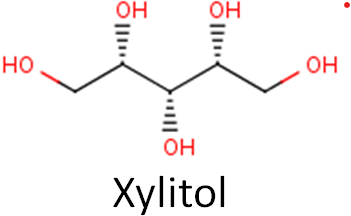(Chemical formula of xylitol from Lumen Learning)
Xylitol is often used as a substitute for sugar. It’s a sugar alcohol processed from a plant fiber called xylan (a clue to how it got its name) or from such trees as birch.
It is sold as a white crystalline powder with a sweetness similar to sugar, but 40% fewer calories and a low glycemic index. It’s in “sugar free” chewing gum, candy, mints, oral hygiene products and more. In people who chew gum sweetened with xylitol, it has been associated with reduction in the types of oral microorganisms that are involved with causing cavities in teeth.
All of this makes xylitol an appealing choice for diabetics and other people who want to avoid sugar.
It also has some antimicrobial properties in other applications. It’s the key ingredient in some nasal sprays that can be used to reduce viral load in case airborne viruses such as SARS-CoV-2 get past other protections and into the nose. Some other nasal sprays are more effective, but sprays based on xylitol are easy for most people to tolerate where more effective sprays can sting or irritate the nose.
Unfortunately it turns out to be not quite the all-good story we thought it was.
Last week a study came out in European Heart Journal saying there is a definite association between xylitol and major adverse cardiovascular events. In particular, investigations in lab settings found it enhances platelet activity and formation of blood clots.
This is causing some alarm among users of xylitol-based nasal sprays. The alarm is misplaced.
The published study is about effects of xylitol when it is ingested (consumed, eaten, swallowed). I don't see any reason to expect xylitol in nasal spray to affect clotting in the bloodstream. Very little will find its way down the back of your throat, into your digestive tract and then into your bloodstream. The nasal spray coats the lining of your nose. It isn’t at all like what happens when you eat some and it gets absorbed.
You may be using a xylitol-based nasal spray as part of your pandemic protections, as we are. We tend to use Xlear before an exposure event and follow up with Enovid or Betadine after the event. This study doesn’t raise a red flag about that.
Cooking with it, sweetening cereal with it, making ice cream with it, anything that involves swallowing a bunch of it would be a different matter. If you have been using it that way, you may want to transition to some other sweetener.
We used to have some xylitol in the house to use that way, but when the package ran out we didn’t replace it. Xylitol is toxic for dogs. It wasn’t worth the worry about whether we might leave anything sweetened with it where our dogs could reach.
P.S.—It’s well established that SARS-CoV-2 increases the risk of blood clots, including microclots. That effect can last a long time (months or years) after the acute phase is past. Personally, I would be wary of adding more to that risk by consuming xylitol.




Mexican Coca-Cola is valued by some because it's made with real sugar instead of corn syrup. I'm a sugar-holic but don't drink soda pop very often. Interesting that Xylitol is made from birch trees. When I did photography for ITT Rayonier in Washington state I was surprised to learn that vanillin was made from wood pulp. (It's also made from other sources, too). My favorite tree product is -- CHOCOLATE! And peaches. And pecans. And....